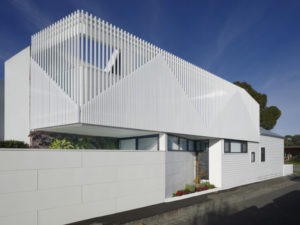Project Description
This 175m² apartment is designed for a family with two small children. It is divided into two unequal parts, with the first part at the front of the apartment near the entrance. This part consists of a kitchen, a living room, a dining room and a master bedroom. The second part is a smaller area at the back of the apartment, which is dedicated to children, comprising two children’s rooms and a play area. A lengthy corridor connects these two parts, with utility rooms along the way: a dressing room/closet, a pantry, a laundry room and two bathrooms.
The front part of the apartment is designed as a free-flowing space, with each area maintaining a visual connection with the others. The master bedroom in this area is connected by wide gates/doors and window-like openings. The bed is raised on a podium and is hidden behind a brick wall, so it is not visible from the living room from any angle. Thus the living area gains a visual extension, but the sleeping area retains its privacy. A protruding volume in the living room enhances the spatial relationship between the bedroom and the living room. It does not reach the ceiling and is trimmed with sheets of black metal to emphasise the subtlety of the structure.
The living area with the TV is raised on a podium and is recessed from the front windows, with moderate lighting, special comfort and a magnificent view from the windows. The living area is separated from the corridor by bookshelves, with a raised lounge for reading, accessed up a removable ladder and with storage space underneath.
The front of the kitchen is set along the whole living and dining space, providing space for plenty of kitchen gadgets. A customised bar counter on wheels can be easily moved along the kitchen and can serve as an additional worktop or serving table. The dining table (also designed by the architect) has unusual proportions: its countertop is narrow and long, visually lengthening the dining area and serving as a link between the kitchen and the living room.
The apartment space devoted to the children’s area was originally very elongated. As a solution, the playroom is placed the furthest from the windows. Its walls are partially made of glass, so as not to lose the natural light. The two children’s rooms have a similar design and each consists of three parts: a bed raised on a wooden podium, a relaxation zone with a sofa, and a work area with a desk and a maximum of light. This design justifies the elongated nature of both children’s rooms. Glass walls separate the relaxation and work areas of the children’s rooms, visually expanding the space and adding light. However, each child can pull down screens or curtains and create privacy.
The décor combines several different textures: dark brick, light oak planks, sheets of black metal, ceramic tile and rough plaster. Glass partitions are widely used in the interior. The playroom isdecorated with tinted cork. All the materials are subject to a specific hierarchy, creating a harmonious ensemble.
The designer included Z-shaped partitions to organise the flowing space within the guest area. Their shape is easily visible from the side. The partitions clearly divide the zones and visually expand each of them. This solution is especially important for the sitting area. A person experiences two opposite emotions in this room. On the one hand, a sense of security and comfort – because of its privacy. On the other hand, a feeling of extra space – because the area expands in all directions above the z-shaped partitions.
There are a lot of podiums in the interior and together they create an intense „landscape“. However, their main function is practical, because all the space underneath is arranged for storage. Overall there are 57 drawers under the podiums, plus two closets and pantries. The owners did not have to buy any storage furniture owing to this solution.






































